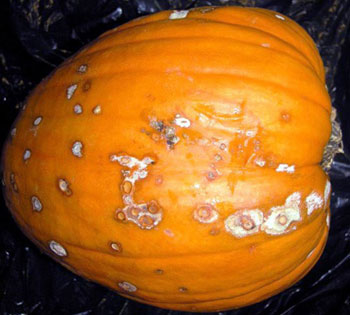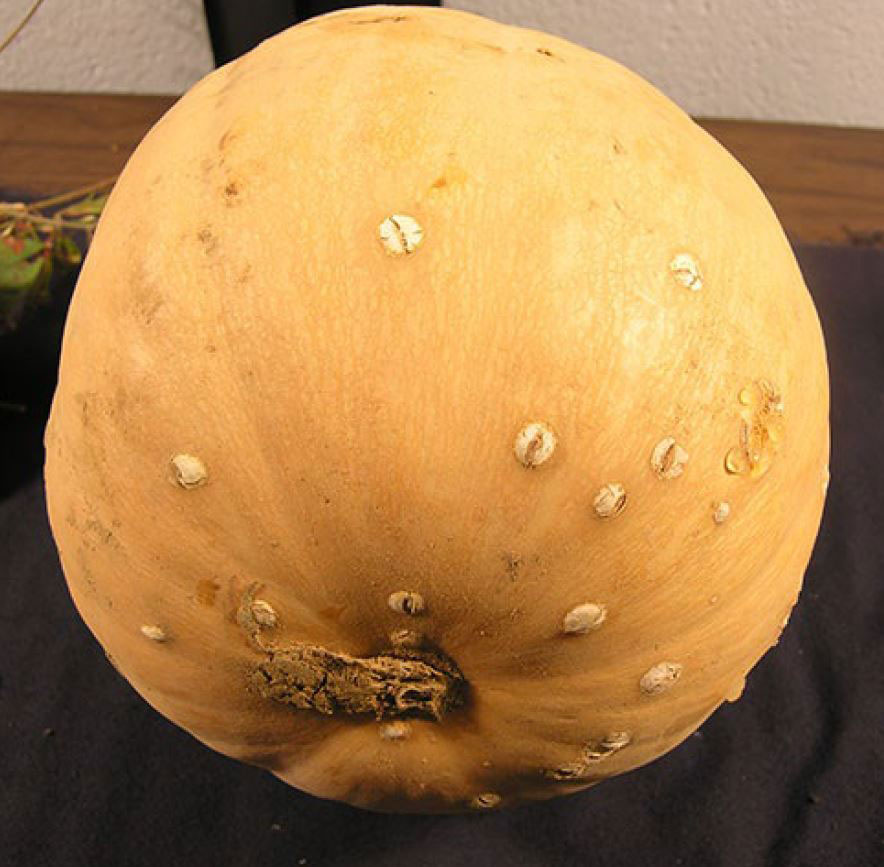Pumpkin Bacterial Spot
Contact
Plant Diagnostician
Phone: (479) 575-2727
Email: ssmith@uada.edu
Jason Pavel
Diagnostician
Phone: (479) 575-7257
Email: jpavel@uada.edu
Office:
University of Arkansas System Division of Agriculture
Cralley Warren Building
Room 16
2601 N. Young Ave.
Fayetteville, AR 72704
Pumpkin Bacterial Spot
Plant Health Clinic Disease Note Issue 32
Sherrie Smith and Jason Pavel

Yield losses of more than 50% have been recorded in fields severely infested with the bacterium Xanthomonas campestris pv. cucurbitae. Pumpkins, cucumbers, gourds, and squash are all susceptible.
What are the symptoms of pumpkin bacterial spot?
Leaf symptoms appear as small, dark, angular lesions, with the centers of the lesions becoming translucent with age. However, the most damaging symptoms appear on the fruit. Fruit lesions begin as small, slightly sunken, circular spots, 1/16 to 1/8 inch (1.6-3.2 mm) in diameter. As the lesions enlarge the cuticle and epidermis crack. Larger lesions may have a scabby appearance with tan, raised blisters. Saprophytic fungi often colonize the older lesions, giving them a pinkish-white or green color depending on the species of saprophyte involved. The unsightliness of the lesions diminishes the marketability of the fruit as well as leading to significant rot in the field and in storage.
How do I control pumpkin bacterial spot?

The pathogen is seedborne and can also survive in crop residue. Bacterial Spot is more of a problem during high temperatures coupled with rainy weather or overhead irrigation. Inoculum is splashed onto young fruit before it develops its protective waxy cuticle. Good sanitation and crop rotation with non-cucurbit crops helps limit inoculum in the field. Rotate away from cucurbits for at least two years. The bacterium has been found to survive on crop debris for up to 24 months. Only clean seed should be used. Therefore, it is advisable to not save seed from a previous crop. Copper fungicides may be applied during early formation and fruit expansion to protect developing fruit. Once bacterial lesions are observed on mature fruit there is nothing to be done except to practice ruthless culling of diseased fruit.
Take Aways:
• Practice crop rotation.
• Dispose of crop debris.
• Use clean seeds.
• Use copper fungicides early.
Follow us on Facebook!
This work is supported by the Crop Protection and Pest Management Program [grant no. 2017-70006- 27279/project accession no. 1013890] from the USDA National Institute of Food and Agriculture.